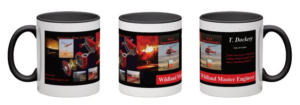The term Master was not intended nor is it supposed to be a catchphrase or jargon or slang, yet at the same time, it is intended to represent an individual who has studied enough and gained the right amount of experience in the wildland fire field to be able to master just about any problem that requires the movement of water. (This includes FireBridge).
What stops most from engaging hydraulics is the thought of math. However, it might surprise you to know that 90% of being a very good Engineer has almost nothing to do with math. Rather it has nearly everything to do with your ability to use deductive reasoning and critical thinking skills foremost. After all, you can’t use a pencil n calculator on a problem if you have no idea what factors are involved right? So, the math simply serves as YOUR witness to either confirm or deny the possibility of an action you are engaging in!
This means that if it’s from as simple as filling up a backpack pump, to the simple & progressive hose-lay, to calculating a water tender shuttle and the number of tenders necessary, to the number and type of engines needed for a task, how much and what size hose for a 3-mile long relay operation to support multiple helicopters at a dip site operation, to even figuring out how much water you need and what size pumps for remote SEAT base operations, the Master engineer is the guy or gal that can do this first in their head by reason, second on paper to prove it!
To take this one step further, the Master engineer could tell you this without even being at the site! If they get good enough, take it seriously, they could be calling in decisions from a remote location and not even have to see the Fire-ground. All of this could be done via map and lat and long. They would know what questions to ask you, and the right ones to outline a job for success. Tell you what you need and where you need it.
Just think, you could even set up progressive draft sites for engines along a road as well. Instead of using several pumps and engines scattered, reduce this to just 1 or 2 type 3 engines, 3 or 4 folks to manage valves, and you have a progressive draft site fed off of one engine and minimal resources (pending distances and elevations of course). This set up can often minimize exposure.
The Master Engineers Test is a test comprising of 9 scenarios. 3 simple hoselays, 3 progressive hoselays, 1 remote SEAT base scenario, 1 helicopter dip site with a relay operation, and an incident within the relay. It’s 73 questions and 85% is required to pass. FireBridge Questions are not included as part of the PDF Test Download here.
The test is designed solely around the Wildland Fire Environment and targets the use of Engines, Helicopters, SEATS, and all things that move water.
Folks become impressed when you can look sharp. They are often more impressed when you can prove to others your ability to perform!
If interested ask to see a sample of what the test would be comprised of.
You are MAILED via USPS mail an 8″ x 11″ certificate with Bristol board backing & cover with a silver border. This is dated, signed, and embossed. Along with your certificate we send you a personalized 11 0z. coffee mug with your name on it free!

